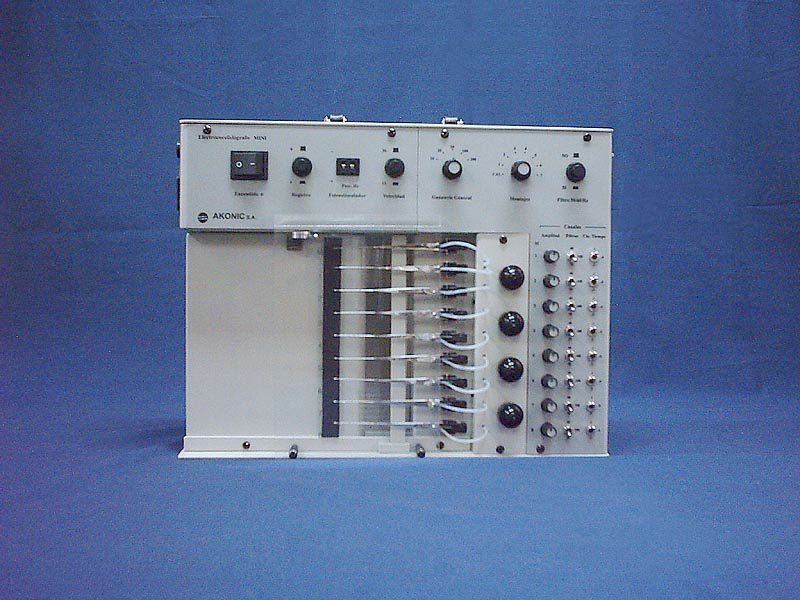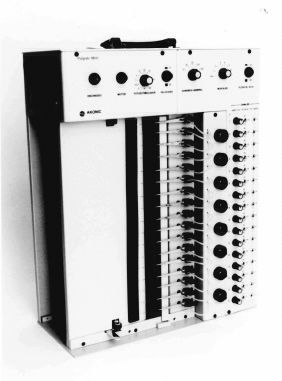Analog electroencephalographs in Buenos Aires City
Teams
We strive to provide excellent medical equipment, therefore, at Akonic SA we have analog electroencephalographs and other excellent quality equipment. Among our products, we have:
4001 (deprecated)
The EMG./PE Mod. 4001 is a device for clinical evoked potentials and EMG, with a plotter-type printer and digital averager.
This equipment can be used in IT rooms and intra-surgical monitoring; In addition, it has a pedal to operate free hands.
The 4001 is a completely portable equipment, totally suitable for being moved.
Security:
- Electrical safety according to EN60601-1 standards.
System caracteristics:
- Line input: 90/230 VAC @ 50/60 Hz.Fuses: 1A - type T (slow).Temperature: 5 - 30 ºC.Relative humidity:< 50 % sin condensación.Autodiagnósticos: test de verificación de punta.Resolución A/D: 8 bits.Amplificador:Impedancia de entrada: > 20 MOhm. Noise level: 0.5 µV. Notch filter by hardware: 50 Hz / 60 Hz. CMRR: > 100 dB @ 50Hz / 60 Hz.

Impedance measurement (optional): online.
Sensitivities: selectable in 1 µV - 2 µV - 5 µV - 10 µV - 20 µV - 50 µV - 100 µV - 200 µV - 500 µV - 1000 µV - 5000 µV per cm of grid on screen.
High Frequency Filters: Selectable in 10 kHz - 8 kHz - 5 kHz - 3 kHz - 2 kHz - 1 kHz - 0.8 kHz - 0.25 kHz - 0.1 kHz - 0.03 kHz.
Low frequency filter: selectable in 1 Hz - 10 Hz - 30 Hz - 150 Hz - 300 Hz.
Toggle filter (Notch): for 50 or 60 Hz.
Analysis time: selectable in 10 - 20 - 50 - 100 - 200 - 500 - 1000 - 2000 in ms throughout the screen.
Latency meter: it is of direct digital presentation, presenting readings between 0.1 ms and 999.99 ms, being able to advance or delay the mark by steps or by keeping the button pressed, automatically.
Averager: allows more than 10,000 averages to be performed, which are not normally used.
Zoom: it also has a form of image magnification, multiplying by 2, by 4, by 16, etc., presenting high-quality images free of noise.
Artifact rejection: among the salient features of the averager is the possibility of connecting automatic artifact rejection, which eliminates those records where noise exceeds memory capacity, saturating the system.
Stimulator: the frequency of repetition of the stimuli, selectable between 0.1 and 32 Hz.
Auditory stimulation: click generator of 100 µsec duration, whose intensity can be varied from 0 to 105 dB in steps of 5 dB for the right, left or both ears. In turn, the opposite ear to the stimulated one can be masked by white noise under the same intensity conditions. The click can be selected as positive, negative or alternating.
Grapher / plotter: the 4001 model also has a grapher that uses common paper with a fiber pencil also in common use, graphing automatically, just by pressing a button, the records memorized on the screen, in the position in which it is located.
Flash visual stimulator: the 4001 unit has a built-in flash visual stimulator, with a head that connects to the rear panel.
Checkerboard visual stimulator (optional): pattern generator, which is external, highly stable and linear (switched power supply) and allows visual stimulation free of noise and interference at any distance the patient is placed. It also has contrast and brightness control and 5 different sizes of checkerboards can be selected.
Somatosensory stimulator: select between 0 and 100 mA, with durations of 0.1 - 0.2 and 0.5 ms, with choice of polarity.
P-300 Tone Generator (optional): you can select 2 tones (A and B), each between 250 - 500 - 1000 - 1500 - 2000 - 3000 - 4000 - 5000 - 6000 - 8000 Hz, with rise-fall time between 0.0 and 9.9 ms in 100 steps of 0.1 ms by digital key and plateau between 0 and 999 ms in 1000 steps of 1 ms, also with digital key.
This allows stimulation with all possible types of known waves (pips, pure tones, tonal BERA, tonal cochleography, burst, etc.).
In turn, another key allows you to select either tone A or tone A and B in a proportion of 90% / 10% - 80% / 70% - 30% / 60% - 40%, a proportion that is maintained randomly, so that so that the patient cannot estimate the next stimulus (whether it is Tone A or B). Averaging can be done when tone A or tone B is output or both. This makes possible all the most modern studies on cognitive evoked potentials.
Mini FH
The mini model electroencephalograph (mini FH) is the most traditional system.
It is an 8-channel analog electroencephalograph, it has direct ink recording, it includes a photostimulator, it presents the option of 7 user-selectable assemblies and it is a portable and very light equipment.
Security:
- Electrical safety according to EN60601-1 standards.
System caracteristics:
- Line input: 90/230 VAC @ 50/60 Hz.Consumption: 93 VA.Fuses: 1A - type T (slow).Temperature: 5 - 30 ºC.Relative humidity:< 50 % sin condensación.Autodiagnósticos: test de verificación de punta.Canales amplificadores de estado sólido (8 canales):Impedancia de entrada: > 20 MOhm.Maximum sensitivity: 1.5 µV/mm.Noise level: > 4 µV.PP between 0.5 - 70 Hz.Hardware Notch filter: 50 Hz / 60 Hz.CMRR: > 100 dB @ 50Hz / 60 Hz.
1 time and event marker channel.
Channels accessible to the user by channel:
Time constants: 0.1 - 0.3 - 0.6 seconds.
Filter: 100 - 70 - 40Hz.
Amplitude: calibration according to the calibration signal.

General User Accessible Controls:
Sensitivity selector: 10 - 25 - 50 - 100 - 200 in µV.
Filtro Notch: 50Hz o 60Hz.
Registration speed: 15 mm and 30 mm per second.
Lead selector selectable between calibration and 7 user-selectable assemblies. The factory standard is for the 10-20 technique: parasagittal - split halo - complete halo anterior tiara - medium tiara - posterior tiara - neonatological or brain death.
Maxi FH (discontinued)
The Maxi FH is a portable, 16-channel analogue polygraph with direct ink recording, it has a time signal marker and a built-in photostimulator. In addition, it has 7 user-selectable mounts with inputs for coupling preamplifiers and transducers for use in polygraphy.
Security:
Electrical safety according to EN60601-1 standards.
System caracteristics:
- Line input: 110 or 220 VAC @ 50/60 Hz (depending on the destination of the equipment).Consumption: 96 VA.Fuses: 1A - type T (slow).Temperature: 5 - 30 ºC.Relative humidity: < 50% without condensation. Recording speed: 15 mm and 30 mm per second. Derivation selector selectable between calibration and 7 preset assemblies. The factory standard is for the 10-20 technique: parasagittal - split halo - full halo anterior tiara - medium tiara - posterior tiara and neonatological or brain death. Visual stimulator frequency by flash: from 0.5 to 25 Hz. 1 marker channel of time and events.
EEG amplifier channels:
Input impedance: > 20 MOhm.
Maximum sensitivity: 1.5 µV/mm.
Noise level: > 4 µVPP between 0.5 - 70 Hz.
Hardware Notch Filter: 50 Hz / 60 Hz.
CMRR: > 100 dB @ 50 Hz / 60 Hz.
Polygraph Amplifier Channels (AC):
- Input impedance: > 20 MOhm. Maximum sensitivity: 1.5 µV/mm. Noise level: > 4 µVPP between 0.5 - 70 Hz. Low frequency filter: 0.5 Hz. High frequency filter: 100 Hz .Notch filter by hardware: 50Hz / 60 Hz.CMRR: > 100 dB @ 50 Hz / 60 Hz.Use: EKG, FA - MIC - BELT1 and BELT2.
Polygraph Amplifier Channels (DC):
- Input impedance: > 220 KOhm. Low frequency filter: DC. High frequency filter: 100 Hz. Maximum input voltage: /- 4 V. Use: oximetry / pH / CPAP pressure / other DC signals.
User accessible controls per channel:
- Time constants: 0.1 - 0.3 - 0.6 seconds. Filter: 100 - 70 - 40 Hz. Amplitude: calibration according to the calibration signal.

General User Accessible Controls:
Sensitivity selector: 10 - 25 - 50 - 100 - 200 in µV.
Notch filter: 50 Hz or 60 Hz.
Registration speed: 15 mm and 30 mm per second.
Lead selector selectable between calibration and 7 user-selectable assemblies. The factory standard is for the 10-20 technique: parasagittal - split halo - full halo anterior tiara - medium tiara - posterior tiara and neonatal or brain death.
Flash visual stimulator frequency: 0.5 to 25 Hz.


